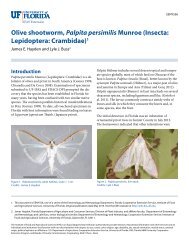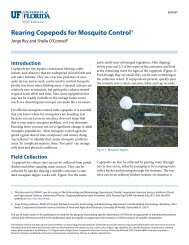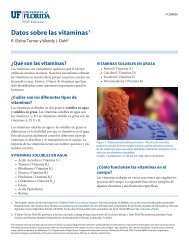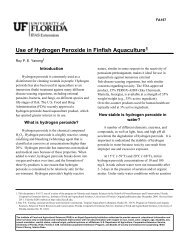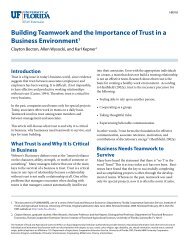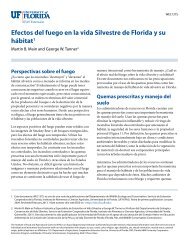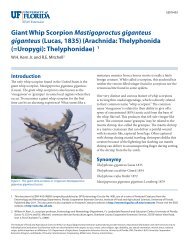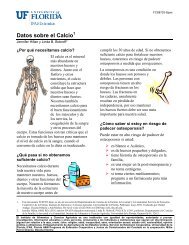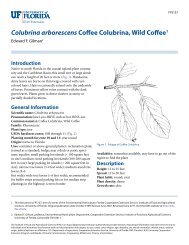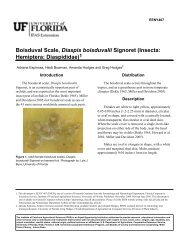Florida Dampwood Termites, Neotermes castaneus - EDIS ...
Florida Dampwood Termites, Neotermes castaneus - EDIS ...
Florida Dampwood Termites, Neotermes castaneus - EDIS ...
You also want an ePaper? Increase the reach of your titles
YUMPU automatically turns print PDFs into web optimized ePapers that Google loves.
EENY122<br />
<strong>Florida</strong> <strong>Dampwood</strong> <strong>Termites</strong>, <strong>Neotermes</strong> <strong>castaneus</strong><br />
(Burmeister), <strong>Neotermes</strong> jouteli (Banks), and <strong>Neotermes</strong><br />
luykxi Nickle and Collins (Insecta: Isoptera:<br />
Kalotermitidae) 1<br />
Rudolf H. Scheffrahn and Nan-Yao Su 2<br />
Introduction<br />
<strong>Neotermes</strong> is a diverse genus of nearly 100<br />
species that live mostly in the world's tropical areas.<br />
Species of <strong>Neotermes</strong> are the largest termites in the<br />
eastern United States. In the eastern U.S., they are<br />
found only in <strong>Florida</strong>. Unlike colonies of<br />
structure-infesting drywood termites (e.g.<br />
Cryptotermes and Incisitermes), <strong>Neotermes</strong> colonies<br />
require higher humidity and regular contact with free<br />
water, and unlike subterranean termites, they do not<br />
forage in the soil.<br />
Over the years, common names have lead to<br />
some confusion. The common name for the<br />
<strong>Neotermes</strong> from <strong>Florida</strong> is not to be confused with<br />
that of Prorhinotermes simplex, a subterranean<br />
species (Family Rhinotermitidae) that, like<br />
<strong>Neotermes</strong>, often nests in fallen logs near coastal<br />
zones. Unfortunately, P. simplex has sometimes also<br />
been referred to as "the <strong>Florida</strong> dampwood termite"<br />
and, for this reason, <strong>Neotermes</strong> in <strong>Florida</strong> have<br />
alternatively been called "southern dampwood<br />
termites" <strong>Neotermes</strong> should also not be confused with<br />
Zootermopsis (Termopsidae), a primitive genus of<br />
"dampwood" or "rottenwood" termites from western<br />
North America.<br />
Distribution<br />
In the United States and its Caribbean territories,<br />
<strong>Neotermes</strong> are endemic to <strong>Florida</strong>, Hawaii, Puerto<br />
Rico, and the Virgin Islands. The three <strong>Neotermes</strong><br />
species in <strong>Florida</strong> have various extended distributions<br />
that include the Bahamas, Cuba, and Mexico.<br />
<strong>Neotermes</strong> are common in the subtropical<br />
woodlands, mangrove forests, and urban settings of<br />
the coastal peninsula of <strong>Florida</strong> and the <strong>Florida</strong> Keys<br />
(Figure 1). <strong>Neotermes</strong> <strong>castaneus</strong> has the greatest<br />
distribution in <strong>Florida</strong> with its northern limits<br />
extending to Merritt Island on the eastern coast and<br />
Pinellas County on the Gulf coast. Inland infestations<br />
of N. <strong>castaneus</strong> have been confirmed in Orlando and<br />
along the shore of Lake Okeechobee. The range of N.<br />
1. This document is EENY-122 (IN279), one of a series of Featured Creatures from the Entomology and Nematology Department, <strong>Florida</strong> Cooperative<br />
Extension Service, Institute of Food and Agricultural Sciences, University of <strong>Florida</strong>. Published: January 2000. Reviewed: March 2008. This document is<br />
also available on Featured Creatures Website at http://creatures.ifas.ufl.edu. Please visit the <strong>EDIS</strong> Website at http://edis.ifas.ufl.edu.<br />
2. Rudolf H. Scheffrahn, professor and Nan-Yao Su, professor, Entomology and Nematology Department, Ft. Lauderdale REC, University of <strong>Florida</strong>, Ft.<br />
Lauderdale, FL.<br />
The Institute of Food and Agricultural Sciences (IFAS) is an Equal Opportunity Institution authorized to provide research, educational information and<br />
other services only to individuals and institutions that function with non-discrimination with respect to race, creed, color, religion, age, disability, sex,<br />
sexual orientation, marital status, national origin, political opinions or affiliations. U.S. Department of Agriculture, Cooperative Extension Service,<br />
University of <strong>Florida</strong>, IFAS, <strong>Florida</strong> A. & M. University Cooperative Extension Program, and Boards of County Commissioners Cooperating. Larry<br />
Arrington, Dean
<strong>Florida</strong> <strong>Dampwood</strong> <strong>Termites</strong>, <strong>Neotermes</strong> <strong>castaneus</strong> (Burmeister), <strong>Neotermes</strong> jouteli (Banks),.... 2<br />
jouteli extends from Vero Beach to the Keys, while<br />
N. luykxi, a relatively newly discovered species, has<br />
been collected from eastern Broward County to Key<br />
Largo.<br />
Figure 1. Distribution of <strong>Neotermes</strong> species in <strong>Florida</strong>.<br />
Credits: Rudolf H. Scheffrahn, University of <strong>Florida</strong><br />
Description and Identification<br />
Colonies of dampwood termites consist of three<br />
primary castes: the reproductives (king, queen, and<br />
unmated winged forms called alates), soldiers, and<br />
false workers or pseudergates (Figure 2). <strong>Neotermes</strong><br />
pseudergates are immature forms without external<br />
signs of wings. When wing buds become visible after<br />
molting, they are called nymphs. The pseudergates<br />
and nymphs excavate and feed on wood to nourish<br />
themselves and their nestmates. Eggs and newly<br />
hatched termites, called larvae, are usually found near<br />
the king and queen. Soldiers constitute about 5% of<br />
the colony population.<br />
A month or two before dispersal flights, nymphs<br />
with long wing buds appear and gradually molt into<br />
alates. <strong>Neotermes</strong> alates are large and have two pairs<br />
of wings that are lightly creased along their vein<br />
paths. Fore wings and hind wings are about equal in<br />
size and shape. Each fore wing has five pigmented<br />
and enlarged veins (costal margin, subcosta, radius,<br />
radial sector, and median) near where they attach to<br />
the body (Figure 3). The enlarged median vein<br />
distinguishes <strong>Neotermes</strong> alates from all other termites<br />
in <strong>Florida</strong> (Figure 4).<br />
Figure 2. Castes in a <strong>Neotermes</strong> <strong>castaneus</strong> (Burmeister)<br />
colony. Credits: Rudolf H. Scheffrahn, University of <strong>Florida</strong><br />
Figure 3. <strong>Neotermes</strong> fore wings. Credits: Rudolf H.<br />
Scheffrahn, University of <strong>Florida</strong><br />
Figure 4. <strong>Neotermes</strong> jouteli (Banks) alate and alates of two<br />
drywood termite species found in <strong>Florida</strong>, Incisitermes<br />
snyderi and Cryptotermes brevis. Credits: Rudolf H.<br />
Scheffrahn, University of <strong>Florida</strong>
<strong>Florida</strong> <strong>Dampwood</strong> <strong>Termites</strong>, <strong>Neotermes</strong> <strong>castaneus</strong> (Burmeister), <strong>Neotermes</strong> jouteli (Banks),.... 3<br />
The following key can be used to further<br />
distinguish alates of the three species of <strong>Neotermes</strong><br />
found in <strong>Florida</strong>:<br />
1a. Head and pronotum sparsely covered with<br />
long (ca. 0.2-mm-long) hairs; body reddish-brown<br />
(Figure 5) . . . . . N. <strong>castaneus</strong><br />
1b. Head and pronotum sparsely covered with<br />
short (ca. 0.05-mm-long) hairs; body reddish-orange<br />
(Figure 6) . . . . . 2<br />
2a. Length with wings 12-14 mm; head width at<br />
eyes =1.59 mm; eye diameter 0.45-0.54 mm;<br />
frons deeply recessed (Figure 8). . . . . N. jouteli<br />
Figure 5. Head and pronotum sparsely covered with long<br />
(ca. 0.2-mm-long) hairs; body reddish-brown. . . . .<br />
Neothermes <strong>castaneus</strong> (Burmeister). Credits: Rudolf H.<br />
Scheffrahn, University of <strong>Florida</strong><br />
Figure 6. Head and pronotum sparsely covered with short<br />
(ca. 0.05-mm-long) hairs; body reddish-orange. Credits:<br />
Rudolf H. Scheffrahn, University of <strong>Florida</strong><br />
Figure 7. Length with wings 12-14 mm; head width at eyes<br />
= 1.59 mm; eye diameter 0.45- 0.54 mm; frons deeply<br />
recessed. . . . . <strong>Neotermes</strong> jouteli (Banks). Credits: Rudolf<br />
H. Scheffrahn, University of <strong>Florida</strong><br />
<strong>Neotermes</strong> soldiers (Figure 9) from the same<br />
colony can differ substantially in size, but all are large<br />
(8.5- 13.5-mm-long) and have at least two marginal<br />
teeth visible on their left mandibles. They differ from<br />
other termites in <strong>Florida</strong> in that their pronotum is as<br />
wide as the head and, at the same time, the width of<br />
the pronotum is much greater than its length. The<br />
following key can be used to further distinguish<br />
soldiers of the three species of <strong>Neotermes</strong> found in<br />
<strong>Florida</strong>:<br />
1a. Eye facets unpigmented; third antennal article<br />
not clavate, similar to second and fourth (Figure 10). .<br />
. . . N. <strong>castaneus</strong>
<strong>Florida</strong> <strong>Dampwood</strong> <strong>Termites</strong>, <strong>Neotermes</strong> <strong>castaneus</strong> (Burmeister), <strong>Neotermes</strong> jouteli (Banks),.... 4<br />
Figure 9. <strong>Neotermes</strong> <strong>castaneus</strong> (Burmeister) soldier.<br />
Credits: Rudolf H. Scheffrahn, University of <strong>Florida</strong><br />
1b. Eye facets darkly pigmented or faintly<br />
darkened; third antennal article clavate, longer than<br />
second or fourth (Figure 11). . . . . 2<br />
2a. Antennal carinae rugose and markedly<br />
protruded; eyes elongate, without satellite facets;<br />
setae on basal mandibular humps distinct (Figure 12).<br />
. . . . N. jouteli<br />
2b. Antennal carinae smooth and only<br />
moderately protruded; eyes subcircular, with satellite<br />
facets; setae on basal mandibular humps vestigial or<br />
absent (Figure 13). . . . . N. luykxi<br />
Life History<br />
As with most other members in the termite<br />
family Kalotermitidae, species of <strong>Neotermes</strong> build<br />
networks of galleries that meander through the wood<br />
in which they are hidden. Alates leave mature<br />
colonies via multiple dispersal flights over<br />
"swarming" seasons that can last for several months.<br />
<strong>Neotermes</strong> jouteli and N. luykxi tend to disperse in the<br />
late spring or summer, while N. <strong>castaneus</strong> has peak<br />
flights in the late fall or early winter. Flights occur at<br />
dusk or at night. <strong>Dampwood</strong> termites are relatively<br />
strong fliers and, like most nocturnal flying insects,<br />
are attracted to lights. Porch lights, indoor lights, and<br />
video monitors often lure the alates inside, especially<br />
when doors and unscreened windows are opened.<br />
When alates are found indoors, their origin is usually<br />
from a yard tree or a woodland colony. Occasionally,<br />
alates found indoors originate from an infestation in<br />
the structure itself. However, alates flying indoors are<br />
unlikely to find the moist wood they need for<br />
successful colonization, and are doomed.<br />
Figure 10. Eye facets unpigmented; third antennal article<br />
not clavate, similar to second and fourth. . . . . <strong>Neotermes</strong><br />
<strong>castaneus</strong> (Burmeister) Credits: Rudolf H. Scheffrahn,<br />
University of <strong>Florida</strong><br />
Figure 11. Eye facets darkly pigmented or faintly<br />
darkened; third antennal article clavate, longer than second<br />
or fourth. Credits: Rudolf H. Scheffrahn, University of<br />
<strong>Florida</strong>
<strong>Florida</strong> <strong>Dampwood</strong> <strong>Termites</strong>, <strong>Neotermes</strong> <strong>castaneus</strong> (Burmeister), <strong>Neotermes</strong> jouteli (Banks),.... 5<br />
Figure 12. Antennal carinae rugose and markedly<br />
protruded; eyes elongate, without satellite facets; setae on<br />
basal mandibular humps distinct. . . . . <strong>Neotermes</strong> jouteli<br />
(Banks). Credits: Rudolf H. Scheffrahn, University of<br />
<strong>Florida</strong><br />
Figure 13. Antennal carinae smooth and only moderately<br />
protruded; eyes subcircular, with satellite facets; setae on<br />
basal mandibular humps vestigial or absent. . . . .<br />
<strong>Neotermes</strong> luykxi Nickle and Collins. Credits: Rudolf H.<br />
Scheffrahn, University of <strong>Florida</strong><br />
Figure 14. <strong>Neotermes</strong> <strong>castaneus</strong> (Burmeister) alate in<br />
exposed galleries. Credits: Rudolf H. Scheffrahn,<br />
University of <strong>Florida</strong><br />
A typical scenario resulting in successful<br />
colonization begins with a male and female alate<br />
pairing after flight. The pair sheds their wings and<br />
selects a nest site such as a crevice in a damp log or<br />
untreated fence post, or a pruning scar, tree hole, or<br />
other entry into a living tree. The alates then crawl<br />
into the existing crack or crevice and seal the entrance<br />
with fecal secretion. A few weeks after mating, the<br />
queen lays her first batch of eggs. The eggs hatch and<br />
the first brood of larvae develop. Over the first few<br />
years, additional batches of eggs are laid and the first<br />
soldiers appear. After a few more years, when colony<br />
population numbers in the hundreds, the first crop of<br />
alates molt and the colony begins its own first<br />
dispersal cycle. <strong>Dampwood</strong> termite colony<br />
populations can reach several thousand individuals<br />
and gallery systems may extend many meters into the<br />
wood.<br />
Figure 15. <strong>Neotermes</strong> life cycle. Credits: Rudolf H.<br />
Scheffrahn, University of <strong>Florida</strong><br />
Damage<br />
Because of their moisture requirements,<br />
structural infestations of dampwood termites are<br />
associated with sources of free water. These include<br />
wood-to-soil contact, wood exposed to roof leaks, or<br />
wooden siding or ornamentation exposed to rainfall<br />
or sprinkler irrigation. Because these same conditions<br />
are conducive to fungal decay and subterranean<br />
termites, it is in the interest of the property owner to<br />
correct these moist conditions. Wood that has been<br />
pressure-treated with chromated copper arsenate<br />
(CCA) is resistant to infestation. <strong>Neotermes</strong><br />
infestations can extend into sound dry wood several<br />
meters away from the moisture source, but once the
<strong>Florida</strong> <strong>Dampwood</strong> <strong>Termites</strong>, <strong>Neotermes</strong> <strong>castaneus</strong> (Burmeister), <strong>Neotermes</strong> jouteli (Banks),.... 6<br />
remote source of moisture is removed, the colony<br />
will gradually decline and succumb to desiccation.<br />
Like drywood termites, dampwood termites produce<br />
fecal pellets, but because of the moist conditions of<br />
the gallery system, the pellets loose their distinctive<br />
shape and form amorphous clumps or paste. The<br />
degree of shape degradation is directly related to<br />
moisture content.<br />
Figure 16. Exposed galleries of <strong>Neotermes</strong> <strong>castaneus</strong><br />
(Burmeister) colony in fallen log showing loose and<br />
clumped pellets. Credits: Rudolf H. Scheffrahn, University<br />
of <strong>Florida</strong><br />
Figure 17. <strong>Neotermes</strong> jouteli (Banks) damage in 4-inch x<br />
8-inch beam removed from a house in Ft. Lauderdale.<br />
Credits: Rudolf H. Scheffrahn, University of <strong>Florida</strong><br />
<strong>Neotermes</strong> <strong>castaneus</strong>, in particular, prefers to<br />
nest in living trees. Colonies are often discovered in<br />
trees when they are pruned or damaged by<br />
windstorms. Robust colonies of N. <strong>castaneus</strong><br />
apparently live in trees and palms for years or even<br />
decades before they are discovered. In one case,<br />
alates of N. <strong>castaneus</strong> were emerging from a Ficus<br />
Figure 18. <strong>Neotermes</strong> jouteli (Banks) soldier and<br />
pseudergates in exposed galleries (note fecal pellets).<br />
Credits: Rudolf H. Scheffrahn, University of <strong>Florida</strong><br />
tree in an indoor shopping mall in New Jersey many<br />
years after the tree was delivered from <strong>Florida</strong>.<br />
Although the galleries may weaken trunks and<br />
branches, the overall health of the tree is usually not<br />
directly affected. The termites appear to limit their<br />
feeding to the dead xylem tissues while avoiding the<br />
cambium. When galleries filled with live N. <strong>castaneus</strong><br />
are exposed, they exude a characteristic fecal or<br />
skatole- like odor.<br />
Figure 19. <strong>Neotermes</strong> <strong>castaneus</strong> (Burmeister) galleries in<br />
oak tree uncovered after pruning (Broward County).<br />
Credits: Rudolf H. Scheffrahn, University of <strong>Florida</strong><br />
Pest Status<br />
The limited conditions that support colonization<br />
by dampwood termites relegate these termites to<br />
minor pest status. Wood damage, however, can be<br />
severe after several years if infestations are left alone.<br />
Damage to trees and branches may cause weakening<br />
but does not appear to harm tree viability although
<strong>Florida</strong> <strong>Dampwood</strong> <strong>Termites</strong>, <strong>Neotermes</strong> <strong>castaneus</strong> (Burmeister), <strong>Neotermes</strong> jouteli (Banks),.... 7<br />
hollowing from galleries might promote secondary<br />
fungal intrusion.<br />
Management<br />
For reasons mentioned above, eliminating<br />
conditions of moisture can control structural<br />
infestations of <strong>Neotermes</strong>. As with the preventative<br />
management of subterranean termites and wood<br />
decay, wood-to-ground and wood-to-water contact<br />
should be eliminated to prevent colonization by<br />
dampwood termites. When untreated wood cannot be<br />
removed from a moisture source, chemical treatment<br />
may be necessary. Boron-containing salts such as<br />
disodium octaborate tetrahydrate (Tim-bor) are water<br />
soluble, so they tend to be drawn into dampwood<br />
termite-infested wood. Borate treatments can be<br />
phytotoxic, however. If desired, galleries in trees or<br />
structural members can be injected and drenched with<br />
site-specific insecticides. On direct contact, these<br />
termites are susceptible to all chemical insecticides.<br />
Selected References<br />
Nagin, R. 1972. Caste determination in<br />
<strong>Neotermes</strong> jouteli (Banks). Insectes Sociaux 19:<br />
39-61.<br />
Nickle, D.A., and M.S. Collins. 1989. Key to the<br />
Kalotermitidae of eastern United States with a new<br />
<strong>Neotermes</strong> from <strong>Florida</strong>. Proc. Entomol. Soc.<br />
Washington 91: 269-285.<br />
Miller, E. M. 1949. A handbook on <strong>Florida</strong><br />
termites. Univ. of Miami Press, Coral Gables. 30 pp.<br />
Scheffrahn, R. H., J. R. Mangold, and N.-Y. Su.<br />
1988. A survey of structure-infesting termites of<br />
peninsular <strong>Florida</strong>. <strong>Florida</strong> Entomol. 71: 615- 630.<br />
Scheffrahn, R.H. and N.-Y. Su. 1994. Keys to<br />
soldier and winged adult termites (Isoptera) of<br />
<strong>Florida</strong>. <strong>Florida</strong> Entomol. 77: 460-474.<br />
Scheffrahn, R.H. and N.-Y. Su. Key to termite<br />
soldiers of <strong>Florida</strong>. Ft. Lauderdale Research Report<br />
96-2.<br />
Scheffrahn, R.H. and N.-Y. Su. Key to winged<br />
termites of <strong>Florida</strong>. Ft. Lauderdale Research Report<br />
96-3.



